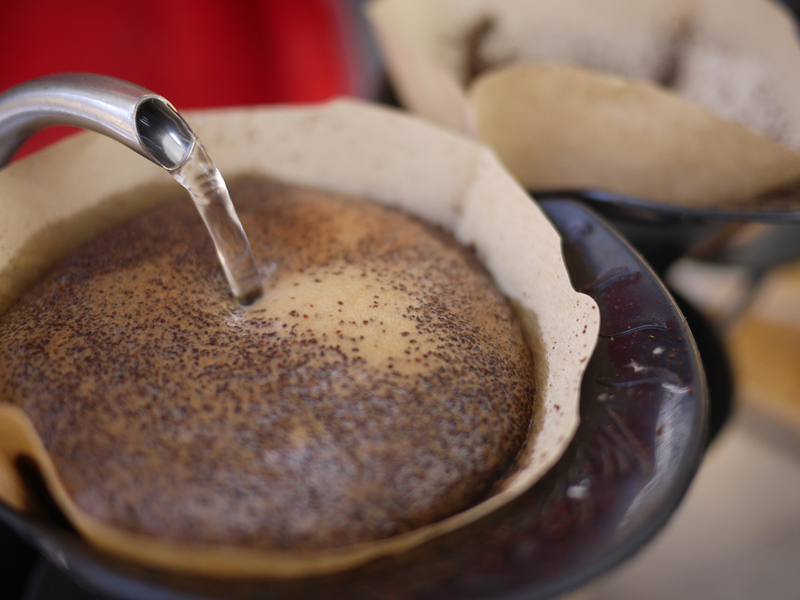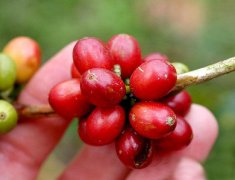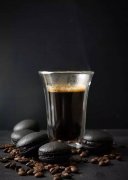More and more attention has been paid to hand-brewing coffee.

Post-espresso era: hand rush prevails
Michael, the 2010 world champion barista. What Michael Phillips performs in the major exhibitions is no longer the old Espresso and pull flowers, but how to flush them by hand. The third wave of the most popular cafes in the United States, # Stumptown Roasters# and # Blue Bottle#, coincided with # Intelligentsia Coffee#, adding a hand-rush bar or race bar next to the espresso machine, often so busy that three people and six hands began to attack and rushed together, unable to digest guest orders.
As a result, the second wave of boutique coffee since 1966, the exclusive situation of espresso has been gradually broken by the third wave of boutique coffee after the millennium, with a more open mind, including Japanese hand brewing, competition style and smart filter cup elements. it has the exotic taste of spreading from east to west, whether you like it or not, please accept the fact that boutique coffee has entered the # post-espresso era. Baristas only know how to play milk foam and pull flowers, which is no longer enough. They still need to develop their hand rush and race style skills in order to keep up with the pace of the times and meet the needs of coffee fans.
The history of hand-made coffee
At present, the third wave of coffee fashion hand-made equipment in Europe and the United States is almost entirely imported by Japan, and it is also the case at home. At first glance, hand-making seems to have been invented by the Japanese. In fact, hand flushing was not invented by the Japanese. As early as the beginning of the 20th century, it was already popular in Germany and the United States, but later declined, and it was refined and carried forward by the Japanese.
The filter paper is put into the filter cup, poured into the coffee powder and then brewed with hot water, which belongs to the more recent extraction method. In 1908, German housewife Merita. Melitta Bentz,1873~1950 was the first to apply for the patent of filter paper and filter cup, which has been popular ever since. Before this, most Europeans used linen, flannel bags or metal mesh to filter coffee grounds, but there were many disadvantages. Although the filter cloth can filter coffee grounds, it will stink if you wash it every time you use it. As for the boiling pot (similar to today's mocha pot), the metal mesh is larger, it is not easy to filter out the fine residue, and it is easy to drink into the scorched residue. Every day, Melita began to experiment with a new method of filtering dregs in order to make a clean, dregs-free and non-bitter coffee.
She tried several filter materials and found that the blotting paper used in her son's homework book was the most effective. at first, she cut the blotting paper into a round shape and spread it on a copper pot with a small hole in the bottom, and became a virgin version of the filter cup. The function of the filter residue is excellent, and it is very convenient to throw it away after use. More importantly, the coffee is clean and sweet, and the bitterness is lower.
After several improvements, Merita filter paper and ceramic filter cups were patented in Germany in 1908 and sold very well in Europe, and the world finally drank clean and residue-free filter coffee. Melita has become the godmother of fan-shaped filter paper and filter cups. German Melita three-hole and four-hole filter cups are popular so far.
In addition, after German chemist Peter J.Schlumbohm 1896-1962 immigrated to the United States, he was inspired by the beaker in the laboratory. in 1941, he launched the follicular pot Chemex, which combines the filter cup and the bottom pot, which is made of heat-resistant glass, and the filter paper used is about 20% and 30% thicker than ordinary filter paper, which is the most important feature and has been popular in Europe and the United States for more than half a century. It can be seen that the extraction method of hot water hand flushing and filter paper filtration has been popular in Europe and the United States in the middle of the 20th century.
The hand is light and elegant, and the taste spectrum is exquisite.
Hand brewing coffee is a typical example of a slow worker who can do fine works. the kit includes a hand pot, filter cup, filter paper and bottom pot. Although it is a little complicated, it can be made by hand as long as it has an electric thermos with a heat preservation of more than 90 ℃. There is no need for gas, alcohol lamps or sockets, so it is highly mobile and very convenient. The Saifeng kettle and the electric trickling filter kettle are boiled under the continuous heating of gas or electric power, and there is no temperature loss problem, but the hand flushing is extracted for 2-4 minutes without the heat source of electricity and gas. From the beginning of the hand flushing, the water temperature gradually drops, which can be called one of the most exquisite extraction techniques among all kinds of bubble methods.
If the handbrewed coffee is brewed at a higher temperature of 90 ℃ to 94 ℃, after 2-4 minutes of extraction, the temperature of black coffee has dropped to between 70 ℃ and 78 ℃. If it is brewed at a lower temperature of 82 ℃ to 89 ℃, the temperature of black coffee may drop below 70 ℃, which is the lowest inlet temperature of all kinds of bubble extraction methods. Therefore, some people who are used to drinking hot coffee are not used to the characteristic of warming their hands without burning them.
Hand flushing technology is good or bad, affecting the taste spectrum to a great extent, high-quality hand flushing is like Qiongjue liquid sweet and mellow, failure hand flushing, three points like acid etching water, seven points like bitter instant coffee. Hand pulping has many variables, either good or bad, due to the extraction water temperature and brewing time, which can be freely selected and regulated. It's good and bad. The disadvantage is that there are too many variables, it is not easy to pinch, and it is easy to be self-defeating. But the advantage is that according to the characteristics of different producing areas and baking degree, different extraction water temperature and time can be designed, and the playing space is infinite and challenging, which is also the reason why players are addicted to it.
On the basis, the coffee flavor spectrum interpreted by hand will be softer, brighter, smoother and layered than siphon style, and the sweetness is no less sweet. However, the thickness of the hand is slightly lower than that of the race style, which should be related to the fact that the filter paper will filter out part of the grease. If the filter cloth is used for hand washing, more grease can be retained, and the thickness is similar to that of the race style. Generally speaking, the competition wind is famous for its mellow and thick, and the hand Chong is famous for its elegant, sweet and sour fragrance, each with its own advantages.
Hand-made tutorials:
The hand has a good nickname-"lazy man's coffee", but there are still a lot of things to study carefully. The representative brand of single bean coffee, the real pot coffee in Japan is famous for making coffee by hand. Although hand-made coffee looks simple, if well controlled, you can definitely make a professional and authentic cup of coffee. In the following, based on my own experience, I will briefly explain the steps and matters needing attention in making coffee by hand.
11. Warm the cup. Everyone knows that the tannins in the coffee do not work as expected, making the coffee very sour, so we should pour hot water into the coffee cup before we start brewing the coffee.
twenty-two。 Grind beans. The thickness of hand-made coffee should also be adjusted according to the characteristics of coffee beans, and the powder thickness of deep-roasted coffee beans should be slightly thicker than that of medium-deep roasted beans. Specifically, the deep-roasted beans of carbon-roasted coffee are 4, while those of medium-and deep-roasted beans like Blue Mountain should be 3. 5. If the bean powder is too thick, the coffee is not strong enough, if it is too fine, the coffee will be very bitter. There is also the problem of the quantity of coffee beans. The amount of beans in a cup of coffee is 12-14g, while the quantity of 2 cups should be calculated by formula-2) X2, three or more cups is simple, 3 times 30g, 4 cups 40g, and so on.
thirty-three。 Assemble utensils. Hand-brewed coffee is mainly composed of three parts, filter paper, filter cup and filter pot. If you pay attention to it, there should be an incubator under the filter pot to prevent the coffee from getting cold during brewing. The size specifications of filter paper, filter cup and filter pot should match. For example, two-person filter paper should be matched with two-person filter cup.
forty-four。 Transfer bean powder. Pour the ground bean powder into the combined filter paper, then gently pat the filter cup to pat the soybean powder and smooth the surface. So that the powder can receive water evenly in the following steps.
fifty-five。 Warm the pot. Pour a small amount of hot water into the bottom pot, shake a few times, and then pour out. Then put the solid bean powder on the bottom pot.
sixty-six。 It is stifling and steaming. The purpose of steaming is to stuffy the aroma of coffee and prepare for the second brewing. The steaming water temperature should be 93 degrees. Pour water from the center of the bean powder and circle it for 2-3 times, so that all the soybean powder can absorb water evenly. It is best to drop 3-5 drops of water. After absorbing water, soybean powder will expand, from the previous flat to the upward protruding arc. At this time, you can smell the faint fragrance of coffee powder. This step is particularly important and is one of the decisive factors in determining the success of a cup of coffee.
seventy-seven。 Brew. After steaming, put the kettle on a moist cloth to cool down. 25-30 seconds later, the water temperature drops to 89-91 degrees, and you can brew. Generally speaking, moderately roasted coffee beans (we call inert beans) have a brewing temperature of 91 degrees, which can better extract the aroma of coffee beans, while deep-roasted coffee beans (lively beans) have a brewing temperature of 89 degrees Celsius. This water temperature is enough to extract the aroma and bitterness of caffeine beans. If the water temperature is too low and a little light, the water temperature is overcooked and extremely bitter. The brewing water can be a little thicker than the steaming one, but it must also be stable. The amount of coffee can be controlled by the number of laps and the speed of the current. Whether it is brewing one or three cups of coffee, the water simply needs to inject water in a circle from the center, then back to the center from the outer circle, to the center of the circle to collect water, and the brewing is over. In the brewing process, be sure not to wash the water into the filter paper, otherwise the coffee will be very astringent. Generally speaking, the amount of coffee brewed should be 0.5 more than the mark of the pot, otherwise the amount of coffee will not be enough.
eighty-eight。 Fill the cup. Shake the coffee in the pot gently before filling the cup so that it is fully mixed so that each cup of coffee tastes evenly. Then pour out the warm cup of water, pour the coffee into the cup and set the plate for dinner.
ninety-nine。 Matters needing attention. The whole coffee brewing process from warm cup to cup to drink (within 4 cups), the time should not be more than 2 minutes, otherwise the taste of coffee will become sour, astringent, and lose its original aroma.
Important Notice :
前街咖啡 FrontStreet Coffee has moved to new addredd:
FrontStreet Coffee Address: 315,Donghua East Road,GuangZhou
Tel:020 38364473
- Prev

There is a kind of tree that we call the coffee tree, the environment in which the coffee tree is generated.
The formation environment of coffee trees in botany, coffee trees belong to the evergreen trees of the subgenus Rubiaceae, and coffee beans, commonly known as coffee beans, are actually the seeds of the fruit of coffee trees, just because they are shaped like beans, so they are called coffee beans. Climate is the decisive factor for coffee cultivation. Coffee trees are only suitable for growing in the tropics or subtropics, so the zone between latitude 25 degrees south and north is generally called
- Next

Coffee roasting process and stage characteristics Coffee bean roasting picture in detail
Every coffee bean contains fragrance, sour taste, sweetness and bitterness. How to release it incisively and vividly depends on the skill of baking. The process and stage characteristics of coffee roasting the flavor of coffee not only depends on the variety of coffee, roasting is also a decisive factor. Basically, the roasting of coffee is a kind of high-temperature coking, which completely changes the substance inside the raw bean and produces
Related
- Beginners will see the "Coffee pull flower" guide!
- What is the difference between ice blog purified milk and ordinary milk coffee?
- Why is the Philippines the largest producer of crops in Liberia?
- For coffee extraction, should the fine powder be retained?
- How does extracted espresso fill pressed powder? How much strength does it take to press the powder?
- How to make jasmine cold extract coffee? Is the jasmine + latte good?
- Will this little toy really make the coffee taste better? How does Lily Drip affect coffee extraction?
- Will the action of slapping the filter cup also affect coffee extraction?
- What's the difference between powder-to-water ratio and powder-to-liquid ratio?
- What is the Ethiopian local species? What does it have to do with Heirloom native species?

